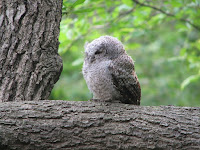EASTERN SCREECH OWL
EASTERN SCREECH OWL – (Megascops asio) – (See images below)
DESCRIPTION: The Eastern Screech Owl northern species comes into a grey morph and a reddish-brown morph. Adult plumage is mottled and streaked and very well camouflaged against tree barks. Facial disk is lighter in color. Ear tufts are clearly visible. Hooked bill is short and grey. Head is large relative to body size. Eyes are small and yellow. Legs and feet are covered in feathers. Sexes are similar, with females larger. Bird length is about 16 cm (7 inches). There are five subspecies.
VOICE: https://www.xeno-canto.org/species/Megascops-asio – In spite of its name, this own does not screech.
NAME: ‘Owl’ is an onomatopoeia for the bird’s call and comes from Cockney. Latin genus name ‘Megascops’ means ‘great owl’, a misnomer given the bird size. Latin species name ‘Asio’ means a short-eared owl.
HABITAT: Forested areas (mixed or deciduous).
DIET: Rodents, insects.
NESTING: Nest is built in a tree cavity, often abandoned by a woodpecker. Will use nest boxes. Between three and seven white eggs are laid, incubated by female. Chicks fed by both parents.
DISTRIBUTION: Year-round resident along south central Canada-USA border, eastern half of Canada and a small region in northeast Mexico.
Distribution Map: https://en.wikipedia.org/wiki/Eastern_screech_owl – /media/File:Megascops_asio_map.svg
ON PEI: Does not breed on Prince Edward Island, sightings listed as ‘accidental’ so far. See note below on bird vagrancy.
CONSERVATION: Widespread and common, currently not at risk. Appears to do well around human habitats.
Vagrancy: In biology this means an animal going way outside its normal range. For birds, this can happen when there are storms and they get blown off course. On other times, the bird simply wanders in a different direction than usual. Here’s an article about vagrancy in birds.
SIMILAR SPECIES: Northern Saw-whet Owl, Boreal Owl
REFERENCES: https://www.audubon.org/field-guide/bird/eastern-screech-owl
American Bird Conservancy (Eastern Screech Owl)
https://www.mba-aom.ca/jsp/toc.jsp (Maritimes Breeding Bird Atlas)
https://nature.mdc.mo.gov/discover-nature/field-guide/eastern-screech-owl (Missouri Department of Conservation)
http://fieldguide.mt.gov/speciesDetail.aspx?elcode=ABNSB01030 (Montana Field Guide)
https://animaldiversity.org/accounts/Otus_asio/ (University of Michigan)
https://txtbba.tamu.edu/species-accounts/eastern-screech-owl/ (Texas Breeding Bird Atlas)
https://birdatlas.mb.ca/accounts/speciesaccount.jsp?sp=EASO&lang=en (Manitoba Breeding Bird Atlas)
https://www.owlpages.com/owls/species.php?s=850
https://www.allaboutbirds.org/guide/Eastern_Screech-Owl/lifehistory
DESCRIPTION: The Eastern Screech Owl northern species comes into a grey morph and a reddish-brown morph. Adult plumage is mottled and streaked and very well camouflaged against tree barks. Facial disk is lighter in color. Ear tufts are clearly visible. Hooked bill is short and grey. Head is large relative to body size. Eyes are small and yellow. Legs and feet are covered in feathers. Sexes are similar, with females larger. Bird length is about 16 cm (7 inches). There are five subspecies.
VOICE: https://www.xeno-canto.org/species/Megascops-asio – In spite of its name, this own does not screech.
NAME: ‘Owl’ is an onomatopoeia for the bird’s call and comes from Cockney. Latin genus name ‘Megascops’ means ‘great owl’, a misnomer given the bird size. Latin species name ‘Asio’ means a short-eared owl.
HABITAT: Forested areas (mixed or deciduous).
DIET: Rodents, insects.
NESTING: Nest is built in a tree cavity, often abandoned by a woodpecker. Will use nest boxes. Between three and seven white eggs are laid, incubated by female. Chicks fed by both parents.
DISTRIBUTION: Year-round resident along south central Canada-USA border, eastern half of Canada and a small region in northeast Mexico.
Distribution Map: https://en.wikipedia.org/wiki/Eastern_screech_owl – /media/File:Megascops_asio_map.svg
ON PEI: Does not breed on Prince Edward Island, sightings listed as ‘accidental’ so far. See note below on bird vagrancy.
CONSERVATION: Widespread and common, currently not at risk. Appears to do well around human habitats.
Vagrancy: In biology this means an animal going way outside its normal range. For birds, this can happen when there are storms and they get blown off course. On other times, the bird simply wanders in a different direction than usual. Here’s an article about vagrancy in birds.
SIMILAR SPECIES: Northern Saw-whet Owl, Boreal Owl
REFERENCES: https://www.audubon.org/field-guide/bird/eastern-screech-owl
American Bird Conservancy (Eastern Screech Owl)
https://www.mba-aom.ca/jsp/toc.jsp (Maritimes Breeding Bird Atlas)
https://nature.mdc.mo.gov/discover-nature/field-guide/eastern-screech-owl (Missouri Department of Conservation)
http://fieldguide.mt.gov/speciesDetail.aspx?elcode=ABNSB01030 (Montana Field Guide)
https://animaldiversity.org/accounts/Otus_asio/ (University of Michigan)
https://txtbba.tamu.edu/species-accounts/eastern-screech-owl/ (Texas Breeding Bird Atlas)
https://birdatlas.mb.ca/accounts/speciesaccount.jsp?sp=EASO&lang=en (Manitoba Breeding Bird Atlas)
https://www.owlpages.com/owls/species.php?s=850
https://www.allaboutbirds.org/guide/Eastern_Screech-Owl/lifehistory
 |
| Eastern screech owl, NY by Wolfgang Wander |
 |
| Eastern screech owl, by Zach |
 |
| Eastern screech owl juvenile, Mark Tillett |